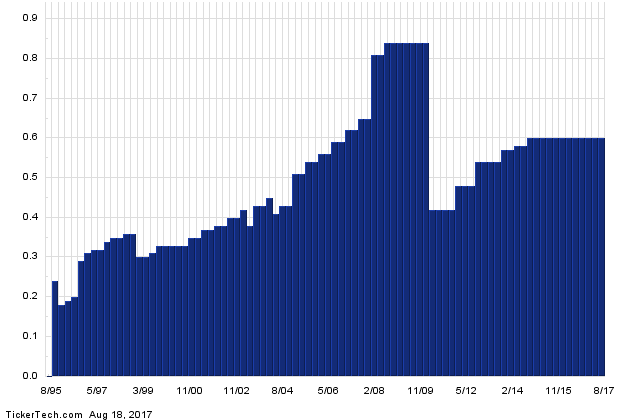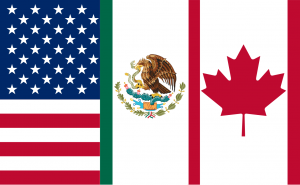Why BP is a Top 25 Dividend Giant
/NewsFrom Nasdaq.com / August 18, 2017, 09:04:03 AM EDT By ETFChannel.com, BNK Invest
“BP p.l.c. (Symbol: BP) has been named as a Top 25 ”Dividend Giant” by ETF Channel , with a whopping $14.39B worth of stock held by ETFs, and above-average ”DividendRank” statistics including a strong 7.04% yield, according to the most recent Dividend Channel ”DividendRank”report. The report noted a strong quarterly dividend history at BP p.l.c., and favorable long-term multi-year growth rates in key fundamental data points.”
“The annualized dividend paid by BP p.l.c. is $2.40/share, currently paid in quarterly installments, and its most recent dividend ex-date was on 08/09/2017. Below is a long-term dividend history chart for BP, which the report stressed as being of key importance. Indeed, studying a company’s past dividend history can be of good help in judging whether the most recent dividend is likely to continue.”
From Nasdaq.com / August 18, 2017, 09:04:03 AM EDT By ETFChannel.com, BNK Invest
Total is buying Maersk Oil in a $7.5 billion deal
/NewsFrom Business Insider / Bate Felix and Jacob Gronholt-Pedersen, Reuters
“Total is buying Maersk’s oil and gas business in a $7.45 billion deal which the French energy major said would strengthen its operations in the North Sea and boost earnings and cash flow.”
“For Danish company A.P. Moller Maersk, the sale of Maersk Oil, with reserves equivalent to around 1 billion barrels of oil, fits with a strategy of focusing on its shipping business and other activities announced last year.”
“The world’s top oil companies have been back on the takeover trail over the last year, helped by signs of a recovery in the oil market.”
“Total expects its biggest oil deal since it acquired Elf in 2000 to generate financial synergies of more than $400 million per year, in particular by combining assets in the North Sea.”
“Total has been betting on new rather than mature fields in the North Sea and the acquisition gives it further economies of scale by making it the second largest player in the region.”
“The deal illustrates Total’s strategy of using a strong balance sheet to acquire attractive assets from competitors having emerged from the prolonged oil downturn stronger than some of its rivals.”
“”It was time for us to do what a real oil and gas company would do in a period such as this when prices are lower and costs are down. Either launch new projects or acquire new reserves at attractive prices,” Total Chief Executive Patrick Pouyanne told reporters.”
“The purchase also signals some oil majors are prepared to invest to replenish reserves and boost production, anticipating an oil price recovery. With current prices of $50 per barrel most majors are simply struggling to balance their books.”
Alternative to float
“Pouyanne said that Total had proposed a deal to Maersk as an alternative to floating the business.”
“”There was a debate within Maersk and they finally accepted given that it was attractive and also the fact that an IPO in a tense oil market would not be a right move,” he said, adding that no other oil major was bidding for the assets.”
“Under the terms of the deal, A.P. Moller Maersk will get $4.95 billion in Total shares and Total will assume $2.5 billion of Maersk Oil’s debt.”
“Maersk said it plans to return a “material portion of the value of the received Total S.A. shares” to shareholders in 2018 and 2019 in the form of extraordinary dividend, share buyback or distribution of shares in Total.”
“Soren Skou, who took charge of Maersk last year, has embarked on a major restructuring to concentrate on its transport and logistics businesses and separate its energy operations in the face of a drop in income.”
“Skou said he had not decided whether to take up the offer of a seat on the Total board.”
“Analysts at Jefferies said the price was 5 percent ahead of its estimates and 18 percent more than consensus of $6.3 billion.”
“AP Moller Maersk shares were up 3.7 percent by 0900 GMT while Total shares dipped 0.7 percent.”
“The Danish oil company has access to high-quality fields in the Norwegian and UK North Sea.”
“Maersk has a 8.44 percent stake in the giant Johan Sverdrup project led by Norway’s Statoil which is expected to start pumping 440,000 barrels per day in 2019, rising to 660,000 bpd by 2022.”
“Maersk is currently developing the Culzean gas field which is expected to start production in 2019 and which could supply up to 5 percent of Britain’s gas demand.”
“Maersk lost a long-standing agreement to operate Al-Shaheen in Qatar to Total last year, but is according to media reports in talks with Iran to develop the oil layer of the South Pars field, which is an extension of the Qatari field.”
“Total last month signed a major deal with Iran to develop the gas part of South Pars.”
“Total also said it was investing $3.5 billion over five years in Qatar’s offshore Al Shaheen oilfield .”
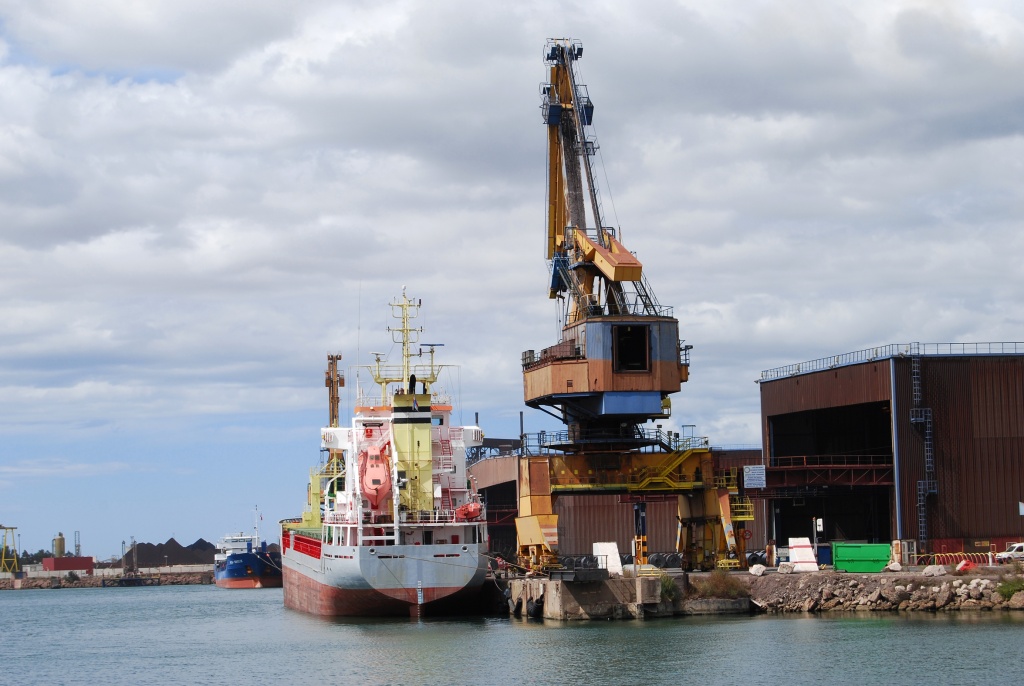
- Steel industry near to sea
Get the latest Oil WTI price here.
Read the original article on Reuters. Copyright 2017. Follow Reuters on Twitter.
From Business Insider / Bate Felix and Jacob Gronholt-Pedersen, Reuters
Mexico Becomes Increasingly Important For U.S. Energy Exports
/NewsFrom Oil Price / By Tsvetana Paraskova – Aug 14, 2017, 10:30 AM CDT
“U.S. energy sales account for more than 50 percent of Mexico’s current energy imports as Mexican energy reforms open the market and as the country is switching to natural gas-fired electricity production, the Washington Examiner reported on Monday, citing an S&P Global Platts report due to be released this week.”
““Pipeline imports of U.S. natural gas make up nearly 60 percent of total Mexican natural gas supply, compared to just 22 percent in 2010,” the report, viewed by the Washington Examiner, said.”
““Platts Analytics expects that U.S. natural gas imports will rise to nearly 70 percent of total supply by 2022,” according to the report.”
“According to the EIA, the U.S.-Mexico energy trade has significantly changed in recent years. Historically, the energy trade has been driven by Mexico’s sales of crude oil to the United States and by U.S. net exports of refined petroleum products to Mexico.”
“The value of U.S. energy exports to Mexico, including rapidly growing volumes of both petroleum products and natural gas, exceeded the value of U.S. energy imports from Mexico in 2015 and 2016, as volumes of Mexican crude oil sold in the United States continued to drop. Last year, the value of U.S. energy exports to Mexico was US$20.2 billion, while the value of U.S. energy imports from Mexico was US$8.7 billion, according to the EIA.”
“According to the S&P Global Platts report, as carried by the Washington Examiner:
“Unable to meet growing demand with local production, Mexico is opening its refined products markets to competition.”
 “Imports of U.S. petroleum products over the first four months of 2017 were up over 125 percent year-on-year. Mexico is in the process of expanding its refined products pipelines and terminals, and allowing outside access to existing assets.””
“Imports of U.S. petroleum products over the first four months of 2017 were up over 125 percent year-on-year. Mexico is in the process of expanding its refined products pipelines and terminals, and allowing outside access to existing assets.””
“In May this year, ExxonMobil announced plans to enter the Mexican fuels market in 2017 by opening its first Mobil service station in central Mexico during the second half, and additional stations will open later this year. ExxonMobil plans to invest about US$300 million in fuels logistics, product inventories, and marketing over the next 10 years.”
“In March, BP opened its first retail fuels site in Mexico as part of a plan to invest in the growing Mexican retail fuel and convenience market over the next five years.”
From Oil Price / By Tsvetana Paraskova – Aug 14, 2017, 10:30 AM CDT
Grupo Mexico sees growth in oil-by-rail, terminals: CFO
/NewsFrom Reuters / By Noe Torres and Marianna Parraga / August 8, 2017.
“Mexico’s mining and infrastructure firm Grupo Mexico expects to expand its oil-by-rail business by building at least three terminals in Mexico, including one exclusively for U.S. refiner Valero Energy, its chief financial officer told Reuters on Tuesday.”
“Grupo Mexico has been in talks with importers of refined products into Mexico, said Xavier Garcia de Quevedo. Fuel purchases from the United States are a growing business as the Latin American country’s demand for imported products keeps increasing.”
“Earlier this month Valero announced that it had signed a long-term agreement with the company to transport fuels by rail from Veracruz to inland terminals in Mexico.”
“”Our interest is to build and operate the terminals, to offer rail services and (access to) the terminals,” Garcia de Quevedo said.”
“He mentioned Torreon, Chihuahua, Mazatlan, Manzanillo and Guadalajara as potential locations for the new terminals.”
“Grupo Mexico, which operates rail lines in Texas and Florida and has a drilling company called Pemsa that has worked for state-run oil company Pemex, is also considering participating in coming oil auctions in Mexico, especially in shallow water areas.”
“Garcia de Quevedo said the company expects to increase about 40 percent its metal melting capacity in Peru, after the government changed an environmental rule for these activities.”
“Grupo Mexico plans to start production at Los Chancas mining project in Peru, with expected capacity of 90,000 tonnes of copper, in late 2021, he said.”
“Garcia de Quevedo was interviewed at the Reuters Latin America Investment Summit.”

Ferrocarril
From Reuters / By Noe Torres and Marianna Parraga / August 8, 2017.
Mexico continues to advance offshore E&P activity
/NewsOffshore Magazine / Houston, 08/11/2017 / Bruce Beaubouef
“The development of Mexico’s offshore oil and gas resources is continuing to ramp up, buoyed by the country’s energy reforms, and despite the prolonged market downturn.”
“Several promising new finds have been made in Mexico’s shallow-water regions. In mid-July, Eni announced that its Amoca-3 well in Campeche Bay has proven multiple significant oil intervals in the Orca and Cinco Presidentes formations.”
“The well was drilled in 25 m (82 ft) of water to a TD of 4,330 m (14,206 ft) in Contractual Area 1, 200 km (124 mi) west of Ciudad Del Carmen, 1.5 km (0.9 mi) southwest of Amoca-1 and 3 km (1.8 mi) northwest of Amoca-2.”
“It intersected 410 m (1,345 ft) of net oil pay, 25-27° API, in several high-quality Pliocene reservoir sandstones; 300 m (984 ft) of the pay were in the deeper Cinco Presidentes sequence, in various Pliocene-age clusters.”
“During the production test, 45 m (147 ft) of the Cinco Presidentes reservoir were opened to production with the well flowing 6,000 b/d of 25° API crude. The Amoca-3 well has since been suspended but will be re-entered later for production purposes.”
“Following the results of this latest well, Eni has lifted its estimate of the Amoca field’s in-place reserves to 1 Bboe. Across Area 1 the total estimated resource base is presently 1.3 Bbbl of oil in place, 90% being oil, with further upside.”
“The company plans to submit an accelerated and phased development plan later this year targeting an early production phase with a plateau in the range of 30,000-50,000 b/d, with operations set to start in early 2019.”
“Exploration of Area 1 continues with the first appraisal well on the Miztón discovery, to be followed by other wells either appraising further finds or exploring undrilled prospects.”
“CEO Claudio Descalzi said: “The Amoca field…represents an optimal opportunity for a phased development approach with a low breakeven. It is an ideal project in this low oil price environment.””
“Descalzi added that “Eni’s objective is to become the first international company to establish operating production in Mexico, which would be the first tangible success of the country’s ‘Reforma energetica’ campaign.””
“But the biggest news – which also came in mid-July – was when Talos Energy reported that its first exploration well offshore Mexico has discovered potentially large oil volumes in the Zama prospect. Results indicate in-place oil in the range of 1.4-2 Bbbl, above pre-drill estimates, and the structure could extend into a neighboring block. Tests of hydrocarbon samples recovered to the surface revealed light oil, with API gravities between 28° and 30° and some associated gas.”
“The ENSCO 8503 semisubmersible drilling rig spudded the Zama-1 well in block 7 in the Sureste basin on May 21 in 546 ft (166 m) of water, 37 mi (60 km) from the Port of Dos Bocas.”
“Initial analysis suggests the well intersected a contiguous gross oil-bearing interval of more than 1,100 ft (335 m), with 558-656 ft (170-200 m) of net oil pay in Upper Miocene sandstones, and no water contact.”
“At present, the well has reached an initial shallow TVD of around 11,100 ft (3,383 m). A liner is being set to protect the discovered reservoirs, prior to drilling deeper exploratory objectives to a TVD of roughly 14,000 ft (4,200 m).”
“There are no plans for immediate well testing, and further evaluation will be needed to calibrate the well with reprocessed seismic in order to determine future plans and optimal follow up locations for delineation drilling.”
“Talos Energy is in partnership with Sierra Oil and Gas and Premier Oil in blocks 2 and 7, respectively offshore the Veracruz and Tabasco states.”
“The dramatic results of the Zama-1 well led CNH to delay its next deepwater auction by a month, to give international bidders more time to evaluate recent major crude discoveries that highlight the potential value of the assets. The commission has now set Jan. 31 as the date for the next round of auctions for deepwater oil and gas tenders in the Gulf of Mexico.”
“The round 2.4 auctions will offer 30 areas, of which 10 are in the Cordilleras Mexicanas deepwater basin, 10 others in the Salina basin, nine in the Perdido Fold Belt off the US-Mexico maritime border, and one more in the Yucatan platform.”
“The Cordilleras Mexicanas deepwater basin is home to national oil company PEMEX’s Lakach natural gas project, and is located east of the Gulf Coast port of Veracruz. Cordilleras Mexicanas is viewed by the oil and gas industry as having extensive untapped potential. The auction will be the first time the basin has been made available to international oil majors, which for decades have profitably developed other fields in nearby US waters.”
“Mexico’s first deepwater oil auction last December included blocks from the Perdido Fold Belt straddling the US-Mexico maritime border, and the Salina basin further to the south.”
“BOEM to offer 76 million acres in Lease Sale 249”
“The Bureau of Ocean Energy Management (BOEM) says it will offer 75.9 million acres offshore Texas, Louisiana, Mississippi, Alabama, and Florida for oil and gas exploration and development in Lease Sale 249.”
“The region-wide lease sale scheduled for Aug. 16, 2017, will include all available unleased areas in federal waters of the Gulf of Mexico and provide a reduced royalty rate for shallow-water leases to encourage exploration and production under current market conditions.”
“Lease Sale 249 will include about 14,220 unleased blocks, located from 3 to 231 mi (5 to 372 km) offshore, in the Gulf’s Western, Central and Eastern planning areas in water depths ranging from 9 to more than 11,115 ft (3 to 3,400 m).”
“Excluded from the lease sale are blocks subject to the Congressional moratorium established by the Gulf of Mexico Energy Security Act of 2006; blocks that are adjacent to or beyond the US Exclusive Economic Zone in the area known as the northern portion of the Eastern Gap; and whole blocks and partial blocks within the current boundary of the Flower Garden Banks National Marine Sanctuary.”
“Scheduled to be livestreamed from New Orleans, this will be the first offshore sale under the national Outer Continental Shelf Oil and Gas Leasing Program for 2017-2022. Under this program, 10 region-wide lease sales are scheduled for the Gulf. Two lease sales will be held each year and include all available blocks in the combined Western, Central, and Eastern Gulf of Mexico planning areas.”
Offshore Magazine / Houston, 08/11/2017 / Bruce Beaubouef
Oil Companies at Last See Path to Profits After Painful Spell
/NewsSource: NYT/ By STANLEY REED / AUG. 1, 2017
ABERDEEN, Scotland — This port city built of granite on the North Sea has taken a battering in recent years. Plunging oil prices hit the petroleum industry, which dominates the economy. Tens of thousands of jobs were slashed. Projects worth billions of dollars were sent back to the drawing board.
Oil executives here now speak with a relief similar to survivors of a fierce storm.
“I feel good about the North Sea, to tell you the truth,” Mark J. Thomas, North Sea regional president for the oil giant BP, said in an interview at the company’s offices near Aberdeen’s airport. “It is remarkably different than where we were even just a few years ago.”
The brighter mood masks what had been a difficult path for the energy sector around the world.
When oil prices fell, the industry scrambled to adjust. It initially relied on tried-and-true tactics: cutting jobs and investment. But then companies realized they had to go further, starting a far-reaching reworking of their businesses to embrace new technologies and construction methods to stretch each dollar just a little more.
The result has been drastically lower operating costs and higher cash flows. Learning to live in a weaker oil price environment gives them upside if prices firm up. This shift was borne out in recent days as major oil companies, including Chevron, Exxon Mobil, Royal Dutch Shell and Total, reported much healthier results.
On Tuesday, BP was the latest to publish its earnings, reporting a $144 million profit for the 2nd quarter compared with a $1.4 billion loss in the period a year earlier.
Companies now reckon that current price levels will most likely persist, and that the $100 oil of a few years ago was “a great aberration,” Daniel Yergin, the oil historian, said in an interview. Indeed, BP’s chief executive, Robert Dudley, said on Tuesday he was planning on the basis that oil prices would remain around their current levels for the next five years.
“Nobody is standing around, waiting for prices to go up substantially,” said Mr. Yergin, vice chairman of the research firm IHS Markit. “The industry is in the middle of re-engineering its processes and its technologies to be a $50 industry, not a $100 industry.”
Many companies have moved to simplify the construction of rigs and platforms, big-ticket items that cut into profit.
 In an era of higher oil prices, companies loaded up oil exploration sites with expensive custom-made extras. But they are moving forward now with stripped-down projects featuring standardized designs aimed at cutting costs.
In an era of higher oil prices, companies loaded up oil exploration sites with expensive custom-made extras. But they are moving forward now with stripped-down projects featuring standardized designs aimed at cutting costs.
BP, for example, sent a $20 billion Gulf of Mexico project called Mad Dog Phase 2 back for a rework. Instead of a giant specially built platform nicknamed Big Dog, the engineers used a smaller apparatus resembling one they were using on another field and reduced the number of wells by a third. When Mad Dog received the green light last year, the price tag had been cut to $9 billion.
Innovations by suppliers are also reducing costs. Aker Solutions, a Norwegian company that supplies the industry with undersea equipment like pipes and processing centers, is working on powering much of this underwater gear with electricity instead of traditional hydraulic fluid, a shift that could cut the costs of undersea projects by 30 percent.
Companies are also looking to data and technology to help extract more oil from the ground, and relying more on video conferences and streaming rather than sending staff members offshore.
The industrywide reassessment is readily apparent in the North Sea, a sprawling area dotted with hundreds of oil fields.
The area, whose fields were discovered half a century ago, has been a crucial contributor to the global energy supply. But output has declined sharply from its peak in the late 1990s, and the costs of extracting oil in the region rose steadily. When prices fell from above $100 in early 2014 to less than $30 just months later, the North Sea was among the most exposed of the world’s oil-producing areas.
“It is difficult when prices are really high, because you are really scrambling,” said Greta Lydecker, Chevron’s managing director for exploration and production in the region. “You are almost getting to a point where you are chasing things, and that is not a good place to be.”
When the price of oil dropped, the poor financial performance of many North Sea fields became impossible to ignore. Then, the cuts came.
Major investments were put on the back burner or scrapped entirely. That, in turn, sent rates plummeting for activities and services like drilling. Between 2014 and 2016, about a quarter of Britain’s oil-related jobs disappeared, according to the trade body Oil & Gas UK; in all, 120,000 people lost work.
More still needed to be done.
Companies began embracing data analysis not just to locate pockets of oil and gas deep beneath the sea floor, but also to improve production efficiency. When a problem crops up in an oil field, for instance, BP engineers can now pull up data on any of the company’s vast network of wells around the world to find solutions that have worked in the past.
“Before, what we would have had to do is scrabble through piles of papers and reports,” said Dave Lynch, BP’s vice president for reservoir development in the North Sea.
The company also began using that data to shut down some wells to gain more production from others, or to fine-tune the volumes of natural gas it injected into its fields to maintain pressure and pump oil to the surface. Mr. Lynch estimates that computer modeling has helped BP boost overall production by 3 to 5 percent in the region.
Operators are using technology to save on staff costs, as well. BP and Chevron are gingerly experimenting with taking some employees from offshore production platforms and having them do their jobs remotely on the mainland, a change that would cut the hefty costs of flying them on helicopters and providing them with food and other necessities.
They have also built centers in key parts of the world, including Aberdeen, that are linked by video to installations that are sometimes far at sea. Initially, staff members were skeptical and workers said they were effectively being spied on. In one case, staff members on a BP platform covered a camera with a sock.
“That’s all gone now,” Mr. Lynch of BP said. “Now, they realize the support they get from the onshore is really important.”
The scramble to slash expenses has already produced results.
It used to cost $97 a barrel in 2015 for big energy companies to break even, after accounting for expenses, investments and shareholder dividends, according to Biraj Borkhataria, an analyst at RBC Capital Markets in London. That figure is now around $55, a drastic cut, albeit one that still leaves costs higher than world oil prices. Major companies are well insulated from day-to-day moves in oil prices, not just by hedging against prices but also because they sell a wide variety of other energy products.
Despite the progress, plenty of challenges remain.
In the short term, traditional oil companies must face off against the shale energy industry in the United States. Not only is shale plentiful, but operators have also lowered costs by improving drilling routines and finding other economies of scale.
And in the longer term, cleaner energy sources like wind and solar are becoming more competitive with oil and natural gas.
But in the North Sea, the change has nevertheless been marked.
“We haven’t been in a profitable position for years,” Mr. Thomas of BP said. The company’s North Sea operations are “heading towards profitability,” he said, “for the first time in a long time.”
American, Canadian, And Mexican Oil & Natural Gas Industries Commit To Energy Trade Alliance Under NAFTA
/NewsOil and Gas Online | News | August 2, 2017
“The American Petroleum Institute (API), Canadian Association of Petroleum Producers (CAPP) and the Mexican Association of Hydrocarbon Companies (AMEXHI) today outlined their shared policy positions on further strengthening the competitiveness of the North American energy industry under the North American Free Trade Agreement (NAFTA). In a joint paper, the three organizations, who collectively represent more than 750 international oil and gas companies in the U.S., Canada, and Mexico, highlighted their support for market-oriented policies and opportunities for commercial growth and job creation.”
““The natural gas and oil industry across North America is united in our support for NAFTA and the significant consumer, economic and security benefits it generates,” said API President and CEO Jack Gerard. “As the energy flows between our countries continue to grow, it’s important to highlight the critical role NAFTA has played in facilitating cross-border trade and investment in energy. The positions we put forward today reinforce our commitment to the energy trade alliance under NAFTA, which supports jobs and manufacturing in energy, helps to make energy more affordable, and enhances our energy security.””
““It is imperative to maintain fully reciprocal market access for Canadian oil and natural gas between Canada and the U.S., as well as enhance trade with Mexico,” said CAPP President and CEO Tim McMillan. “Since NAFTA’s inception in 1994 our three nations’ economies have become interconnected and integrated. The logic in supporting a free trade zone is more compelling today than ever before which is reflected in our joint position to strengthen our deep trade relationship for all three countries.””
““After Mexico’s Energy Reform, NAFTA itself enabled much of the investment attraction, infrastructure development and a more intensive commercial exchange,” said AMEXHI President Alberto de la Fuente. “The synergy between NAFTA and the Energy Reform in Mexico is essential to attract investments, develop integrated value chains and increase North America’s economic competitiveness.””
“The joint paper outlines the North American oil and natural gas industry’s positions on specific policy areas of NAFTA, including the preservation of tariff reduction and elimination in the trade of energy products, market access, a modernized system of certificates of origin, regulatory cooperation, and fully liberalized trade across North America. It also highlights the support for preserving provisions for strong investment protections and Investor-State Dispute Settlement (ISDS), including rules that restrict expropriation of investments and that provide for prompt, adequate and effective compensation when expropriation does occur.”
“The joint position paper is available on API’s website here. To learn more about the benefits of North American energy integration, click here.”
“API, CAPP, and AMEXHI work on behalf of our international oil and gas member companies to enhance the opportunities for oil and natural gas production and manufacturing and improve the competitiveness of the industry in North America and in the worldwide economy. The three organizations combined represent over 750 international oil and gas member companies, and support opportunities for economic growth and job creation under NAFTA.”
SOURCE: The American Petroleum Institute (API)
Oil and Gas Online | News | August 2, 2017
Mexico’s first publicly listed oil company set for August debut
/NewsBusiness Insaider – Reuters- Sheky Espejo- July 26, 2017
“Vista Oil & Gas, with backing from private equity firm Riverstone Capital, will launch an initial public offering (IPO) on Mexico’s stock exchange on Aug. 11, according to three sources with knowledge of the deal and a document seen by Reuters.”
“The IPO would mark the entry into Mexico’s stock exchange of the country’s first publicly traded oil company, four years after a landmark constitutional oil reform ended the decades-long monopoly enjoyed by national oil company Petroleos Mexicanos, better known as Pemex.”
“A Vista spokesperson did not immediately return a phone call requesting comment.”
“Riverstone is also a major investor in privately held Sierra Oil & Gas, launched in 2014, the first Mexican oil company formed since the reform.
“The Vista debut, the first special purpose acquisition vehicle (SPAC) in Mexico, plans to raise at least $500 million by offering 50 million Series A “units” valued at about $10 per unit, according to the prospectus.”
“SPACs are publicly traded buyout companies that raise funds through an IPO with the goal of later completing acquisitions. They are commonly used in non-conventional oil and gas projects in the United States.”
“A two-week investor roadshow for Vista kicked off on Monday in New York, and will move on to Toronto, London and Boston, according to the document.”
“The Vista management team includes former executives of Argentina’s national oil company YPF including that company’s ex-CEO Miguel Galuccio.”
“The company’s acquisition targets range from Mexico, Brazil, Colombia and Argentina.”
“Energy infrastructure company IEnova, a unit of U.S. firm Sempra Energy, has traded on the Mexican stock exchange since 2103, but is not involved in exploration or production activities.”
“Mexican conglomerates Alfa and Grupo Bal are also both listed and have oil and gas units, but investors can not directly invest in those units. (Reporting by Sheky Espejo; Writing by David Alire Garcia; Editing by David Gregorio).”
Business Insaider – Reuters- Sheky Espejo- July 26, 2017
Mexico conducts first open season on natural gas pipeline capacity
/NewsDaily Energy Insider – Debra Flax – July 26, 2017
“Continuing the country’s ongoing energy reforms, Mexico’s National Center for Natural Gas Control (Centro National de Control del Gas Natural—CENAGAS) recently conducted Mexico’s first natural gas grid capacity open season to auction pipeline capacity rights, according to the U.S. Energy Information Administration.”
“CENAGAS manages Mexico’s Integrated National Natural Gas Transportation and Storage System (Sistema de Transporte y Almacenamiento Nacional Integrado de Gas Natural—SISTRANGAS), which currently has a pipeline length of 6,256 miles with a total transportation capacity of 6.3 billion cubic feet per day (Bcf/d).”
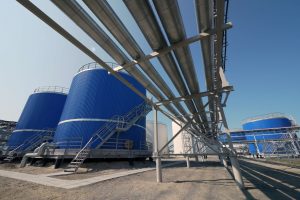
“Created in 2014, CENAGAS is the decentralized public organization that assigns capacity rights for pipelines previously owned, operated, and largely used by PEMEX, Mexico’s national energy company. As PEMEX had been the monopoly controller over all of the country’s pipeline assets, Mexico’s energy reforms chose to dismantle the PEMEX monopoly, transitioning the energy sector to a more open market.”
“In order to smoothly transition to the new market structure, two open seasons were scheduled, “Round 0” and “Round 1”. The Round 0 phase occurred in October of 2016, where 1.1 Bcf/d was reserved for Mexico’s Federal Electricity Commission (Comisión Federal de Electricidad–CFE) and 1.4 Bcf/d was reserved for PEMEX. Another 1.6 Bcf/d of capacity was reserved for Mexico’s independent power producers, which hold long term contracts to sell power to the CFE. They are not subject to any short-term capacity auctions. Due to this, only 2.2 Bcf/d of the 6.3 Bcf/d capacity was up for auction for the Round 1 auction.”
“Round 1 auctions were held in May 2017. While 24 local and international companies vied for 3.6 Bcf/d, CENAGAS allocated the 2.2 Bcf/d to PEMEX (receiving 59 percent), ENGIE Mexico and ArcelorMittal (each receiving 7 percent), Shell Trading Mexico (receiving 6 percent), and Group Alpha (receiving 5 percent). ENGIE Mexico, Shell Trading Mexico, and Groupo Alpha are all natural gas allocations and services, while ArcelorMittal is one of the largest steel manufacturers in the world.”
“The remaining 15 percent of capacity went to 19 other companies, many of which are in the natural gas retailing and marketing business. Overall, the interested companies were drawn to the injection points supplying U.S. natural gas to Mexican pipelines.”
“Companies awarded capacity began taking over state-owned operators on July 1 for one-year contracts.”
“CENAGAS held another auction for five cross-border pipelines assigned to the Federal Electricity Commission on July 10. However, no final bids were submitted and the auction was declared void. On August 10, CENAGAS expects to hold another auction for capacity on the five cross-border pipelines.”
Daily Energy Insider – Debra Flax – July 26, 2017

Latest News
 Breaking Barriers and Building the Future18 March, 2025
Breaking Barriers and Building the Future18 March, 2025 Fundamental factors to strengthen Pemex12 August, 2019
Fundamental factors to strengthen Pemex12 August, 2019 Offshore Project Development: The Road to First Oil26 July, 2019
Offshore Project Development: The Road to First Oil26 July, 2019
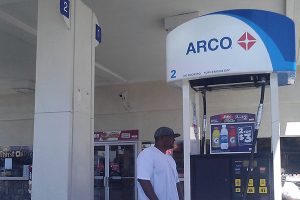 “The move comes at a time when many foreign companies are opening gas stations or entering into distribution and supply deals in Mexico. London-based oil giant BP opened a gas station in a Mexico City suburb were eager drivers endured long lines to fill up their tanks at its debut in March. San Antonio-based refining company
“The move comes at a time when many foreign companies are opening gas stations or entering into distribution and supply deals in Mexico. London-based oil giant BP opened a gas station in a Mexico City suburb were eager drivers endured long lines to fill up their tanks at its debut in March. San Antonio-based refining company 